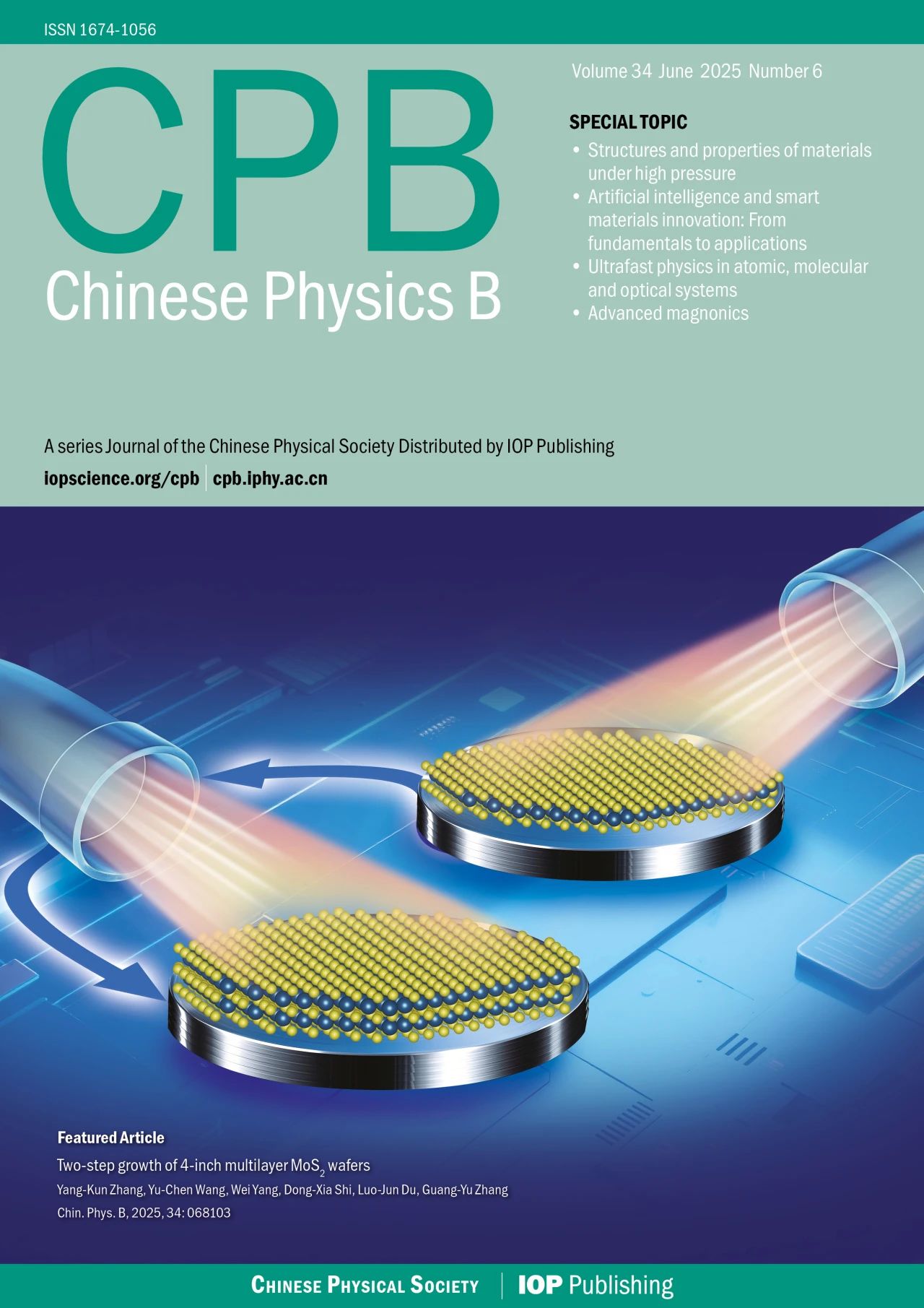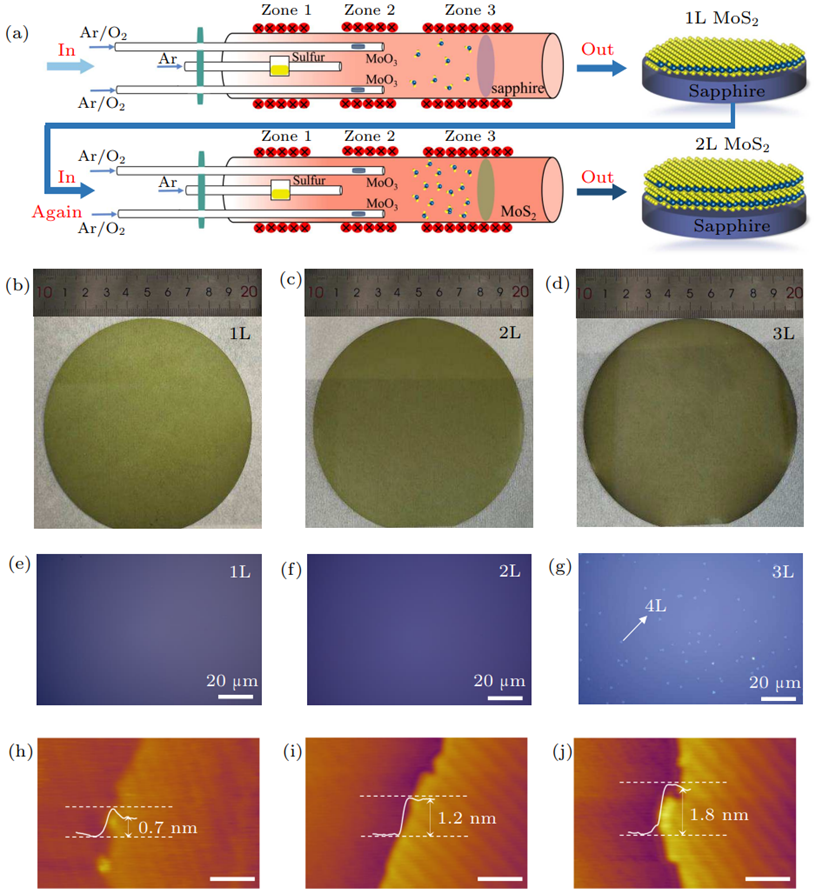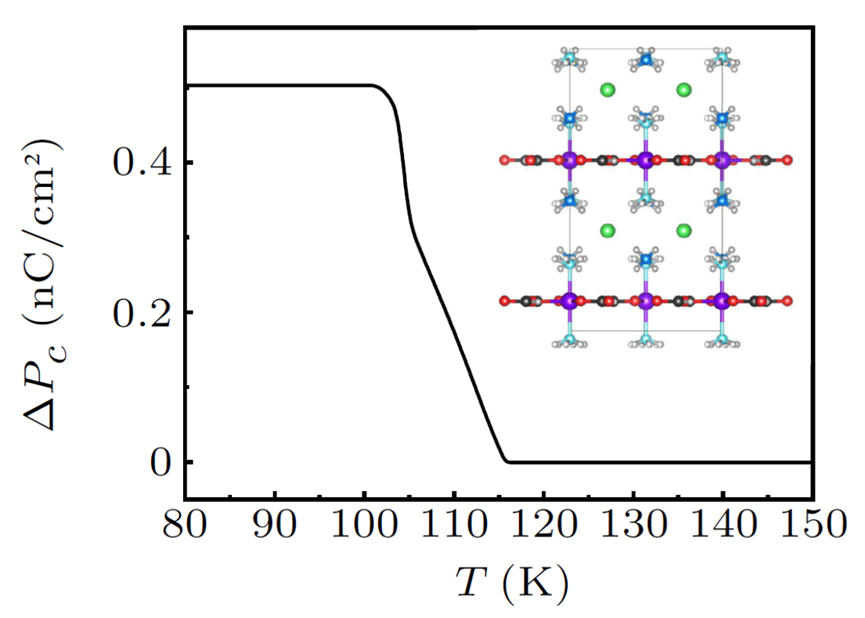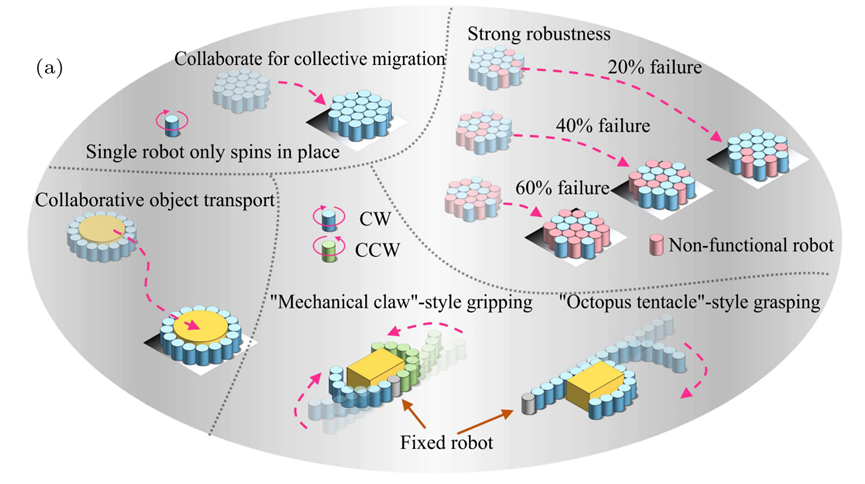博文
[转载]CPB封面文章和亮点文章 | 2025年第6期
||


Two-step growth of 4-inch multilayer MoS2 wafers
Yang-Kun Zhang(张养坤), Yu-Chen Wang(王雨辰), Wei Yang(杨威), Dong-Xia Shi(时东霞), Luo-Jun Du(杜罗军), and Guang-Yu Zhang(张广宇)
Chin. Phys. B, 2025, 34 (6): 068103

二硫化钼(MoS2)作为最具潜力的二维半导体候选材料之一,未来有望超越传统硅基器件,并在纳米电子学和光电子学等领域展现出广阔的应用前景。为了更加充分地发挥MoS2的应用潜力,实现大面积、高质量、层数均匀的多层MoS2薄膜的可控制备非常必要,但目前非常具有挑战性。
本文作者设计了一种两步氧辅助化学气相沉积(OA-CVD)方法,并在蓝宝石衬底上实现了从单层到三层的四英寸MoS2薄膜晶圆的可控制备。另外,与之前的一步直接生长策略相比,两步OA-CVD策略可以精确控制每一层MoS2的独立生长,从而为探究不同生长参数对多层MoS2生长的影响提供了可能。与基于单层MoS2薄膜的柔性场效应晶体管相比,由双层(三层)MoS2制成的柔性场效应晶体管具有更加优异的器件性能。本工作为研究多层二维范德华材料的生长调控和可控制备提供了新的见解。

Fig. 1. Two-step OA-CVD epitaxy of 4-inch MoS2 wafers from monolayer to trilayer. (a) Schematic diagram of the two-step OA-CVD process. (b)-(d) Photographs of 4-inch MoS2 wafers: (b) monolayer, (c) bilayer, (d) trilayer. (e)-(g) Optical images of wafers shown in (b)-(d). Scale bars: 20 µm. (h)-(j) AFM amplitude images taken from mono-, bi- and tri-layer wafers. Scale bars: 200 nm.

Dan Cheng(程丹), Yingjie He(何英杰), Shuang Liu(刘爽), Na Su(苏娜), and Young Sun(孙阳)
Chin. Phys. B, 2025, 34 (6): 067505

金属-有机框架是一种无机-有机杂化材料,可以同时具有磁有序和铁电(反铁电)有序,即多铁性。近年来,随着二维材料引起学术界的广泛关注,人们也在尝试合成具有层状结构的二维金属-有机框架。但是,关于层状二维金属-有机框架的磁性和电学性质的研究还很少。
在本论文中,我们合成了一种Ni基层状二维金属-有机框架材料,通过磁性、介电和热释电的测量,发现该层状金属-有机框架具有反铁磁有序和弱铁电性,是一种第一类多铁性材料。其结构/铁电相变温度在外加磁场下往高温移动,表现出较强的磁弹耦合。并且,伴随着铁电相变,其c轴出现负热膨胀效应。本文的研究表明二维金属-有机框架材料为多铁性和反常热膨胀研究提供了新的舞台。

Fig. 1. Pyroelectric current as a function of temperature along the
c-axis. Insert is the illustration of the layered structure of the Ni–MOF.

Xingyu Ma (马星宇), Chuyun Wang (汪楚云), Jing Wang (王璟), Huaicheng Chen (陈怀城), Gao Wang (王高), and Liyu Liu (刘雳宇)
Chin. Phys. B, 2025, 34 (6): 068701

使用机器人集群研究活性物质的性质是一种常见的实验手段,机器人往往需要具备计算、存储、感知和二维运动能力,以便完成预先设定的规则。在这些规则的作用下,群体可以完成复杂的任务,涌现出丰富的集群态或产生有趣的相变现象。本文展示了一项如何通过个体间的弱耦合磁连接方式,将只具有简单环境光强响应的一维自旋运动机器人,构建成能够完成群体趋光性运动、折叠抓取、合作搬运物体等实际群体任务的集群机器人。并且证明了该群体具有极强的系统容错性,在群体中失效个体比例超过半数时,群体依然能够完成集体任务。
本研究表明,除了常见的设计精巧的个体以及出色的个体间交互规则外,通过适当的结构以及个体间的耦合设计,也能让不具有计算能力的个体通过群体间的合作产生复杂的群体行为,完成多样化的群体任务。这为活性物质的机器人实验研究提供了一种简单系统涌现复杂行为的独特实验研究思路。

Fig. 1. Structure and functionality of the robot system. (a) A single robot can only spin in place, but when multiple individuals are coupled together, collective functionalities emerge, exhibiting strong robustness that can tolerate the failure of more than half of the robots. Swarms of robots with different chirality can form chain-like structures to grasp, grip target objects, or collaboratively transport them.

Instrumentation and Measurement
Computational Programs for Physics

Celebrating 30 Years of Chinese Physics B
Stephen J. Pennycook: A research life in atomic-resolution STEM and EELS
Recent progress on kagome metals and superconductors
Moiré physics in two-dimensional materials
Computational programs in complex systems
Quantum computing and quantum sensing
Structures and properties of materials under high pressure
Post-Moore era: Materials and device physics
States and new effects in nonequilibrium
Smart design of materials and design of smart materials
Superconductivity in vanadium-based kagome materials

长按二维码,关注我们
https://iopscience.iop.org/journal/1674-1056
从投稿到录用平均审稿周期:2个月
文章录用后2天内网上预出版(DOI)
每期评选封面文章、亮点文章并多渠道宣传推送
入选“中国科技期刊卓越行动计划”
https://wap.sciencenet.cn/blog-3377544-1491816.html
上一篇:[转载]CPB 推出“Letters”精品栏目
下一篇:[转载]CPB2025年第6期编辑推荐文章